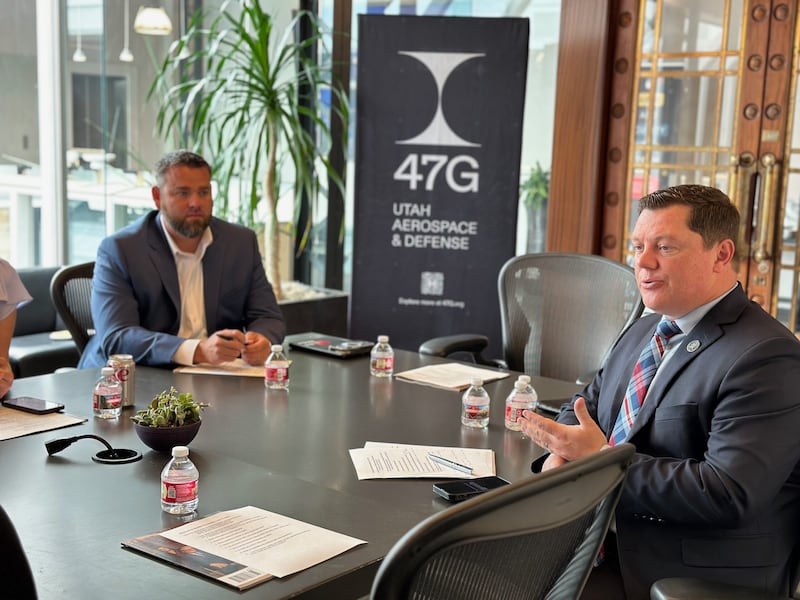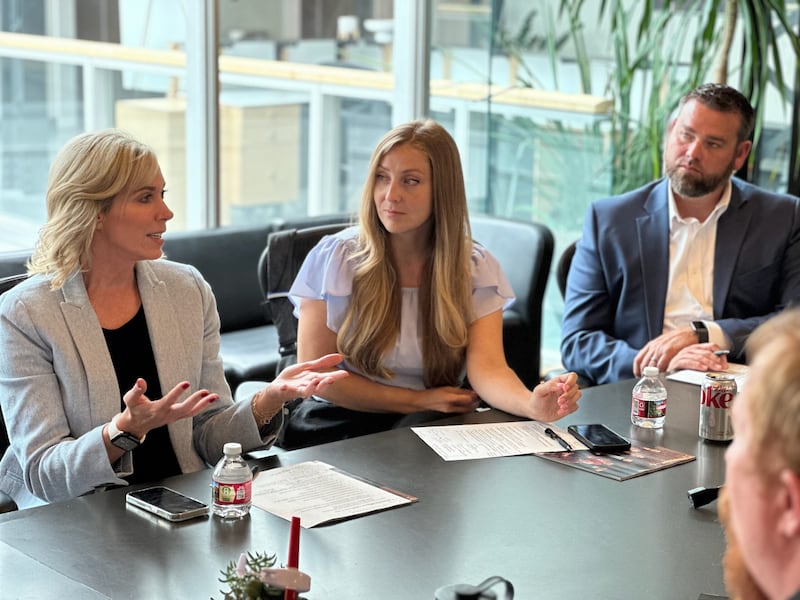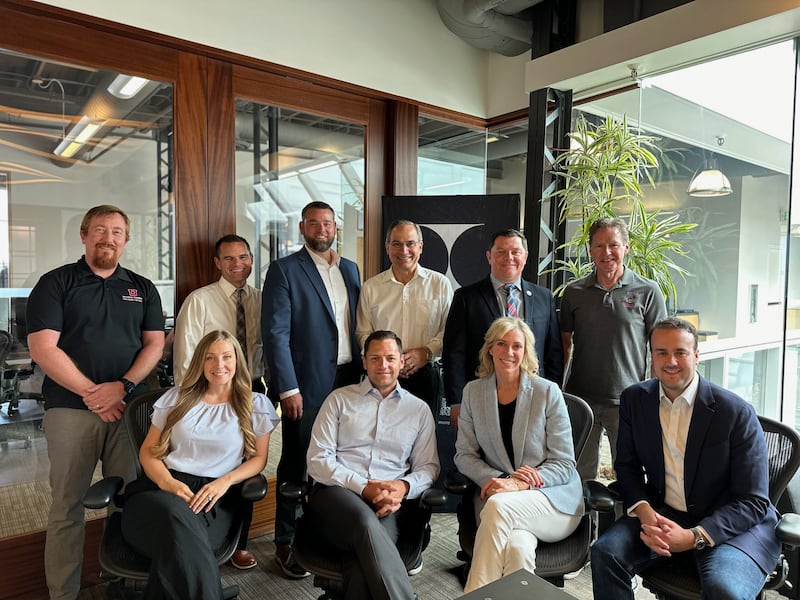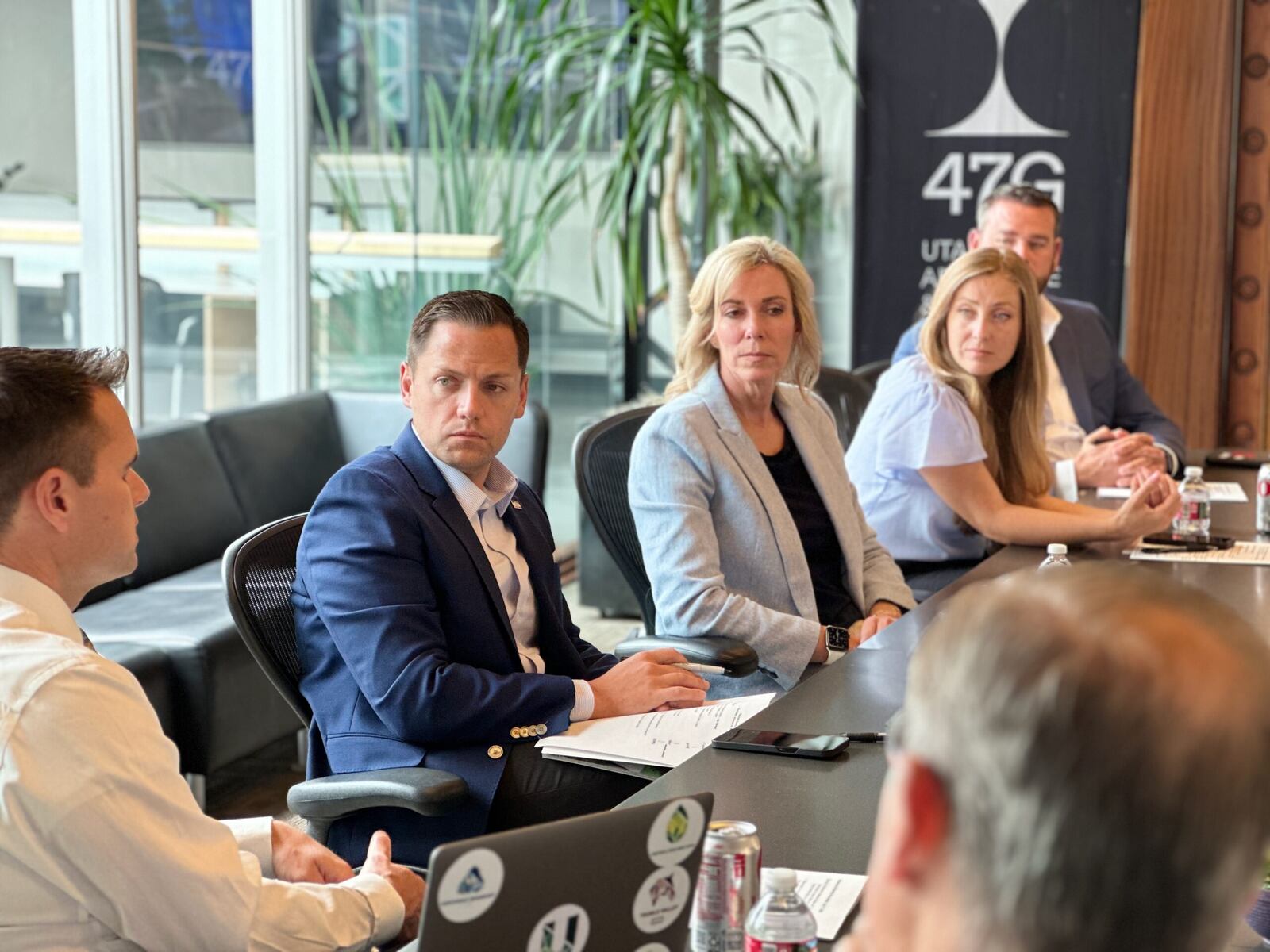(AAM). Moderated by Aaron Starks, president and CEO of 47G, they discussed current implementations, economic impact, required infrastructure and more.
What is AAM?
Paul Damron | Advanced Air Mobility Manager | Utah Department of Transportation (UDOT)
AAM is a new and innovative way of moving people utilizing efficient, electric aircraft — and not only moving people but also logistics, from small packages to heavy cargo. … With this new technology innovation in aviation, companies are developing new and improved aircraft that can be more efficient to the economy and more efficient to us as we’re traveling. It collectively includes all of that.
Chris Metts | Executive Director, Advanced Air Mobility | 47G
AAM has to start with safety, security and economic viability. … There are communities around the globe that are advancing these technologies and implementing them. Just a couple of weeks ago, the Kingdom of Saudi Arabia announced plans to build and construct 125 vertiports in the next five years. Dubai is already running an autonomous air taxi service. You can order the air taxi to a location and have it take you to a location. Several states already have vertiports in place and aircraft that are being tested and evaluated.
Ben Hart | Executive Director | Utah Inland Port Authority
As we talk about what makes an economy successful, there are two things that I always point to: workforce and transportation. You get those two things right, and you can get a lot of other things wrong, quite frankly. You get those two things wrong, and it doesn’t really matter what else you’re doing right. The movement of goods and people is absolutely critical for our economic success. … Our goods and we, as people, are going to move differently 20 to 40 years from now. If we don’t stay on top of this as economic leaders, our entire economy — the entire state — is going to start to lose ground to other states.
Why Utah? Why now? Why is this important for our economy?
Julie Fullmer | Mayor | Vineyard City
Vineyard is in a really lucky position where we’re building from the ground up. As I was looking around the corner for where transportation was heading, how to build our economy, and how to move people throughout my city and the region — as we’re the connecting point for transportation in the Wasatch Front — I realized this was the next generation of aviation innovation.
Community engagement has to be at the very forefront of implementation when it comes to driving new technologies like AAM. It’s not really new, but it feels new, and there are new regulations that have to come with it. How do we deregulate? How do we set new policy? How do we set standards that we’re not really talking about? That’s what Vineyard has really been driving forward: our policy and our infrastructure, and then creating those partnerships between those who are actually going to drive this and make it possible for all of our community members to engage in this type of technology.
Ryan Starks | Executive Director | Governor’s Office of Economic Opportunity
AAM is the next evolution of innovation in Utah. We live in a state that’s less than 200 years old. Think about our transportation history, from the early settlers with their handcarts to the train, the advent of the automobile and the advent of the airplane. Now we have TRAX and FrontRunner. This is the next step in the evolution, and it’s a needed step. As one of the fastest-growing states in the United States, we need to stay in front of population growth, logistical challenges and opportunities.
We really see this as a critical piece of Utah’s economic future because it’ll solve congestion and increase efficiency in terms of the delivery of people and products. … The beauty of AAM is that it also benefits rural parts of the state. We saw this during COVID-19 — people could not get access to some of their medications or needed medical services. Now, AAM provides an opportunity for people on and off the Wasatch Front to have access to those critical needs.
Ben Hart | Executive Director | Utah Inland Port Authority
One of the statistics we’re really concerned about is that Utah has the highest percentage of trucks on its roads compared to any other state in the country. We are a road-based state. We all love our personal vehicles, as well. If we continue down that path, we’re going to see air quality continue to diminish. We’re going to see communities that are left behind, communities that don’t have as good of access to the roadway as others do and ultimately don’t have those same economic opportunities. There are a lot of winners and losers when it comes to being so heavily dependent on roads, and the more we can change that dynamic, the more success we’re going to have statewide. We’re really focused on how to do more via rail but also how to do more via air as well.
Amanda Covington | Chief Corporate Affairs Officer | The Larry H. Miller Company
As we’re looking at downtown Daybreak, Mountain View Corridor plays an incredible role. Transit plays a great role in getting a new TRAX stop there so people can learn to take transit to the game before they ever think about taking a car. But when we think about the future and moving people north, south, east, west to a game, out to dinner or maybe to a job, air mobility adds another layer. … As we look at the Power District, we’ve learned a lot from the Utah State Fairpark in terms of the ebb and flow of events. They do the rodeo, state fair, and a number of events and festivals each year. There’s a lot of worry in that community as you bring, potentially, more activity there. How do you move people in and out?
Imagine the ability to use the air and those pathways to move people effectively, with less pollution and potentially safer, in and out of venues to create a sense of place and connection. We believe that life happens where people and places meet. … As we are working on baseball, people from St. George to Logan say, “Well, how does it benefit me? How do I enjoy partaking in these major league sports?” The opportunity for somebody to be able to quickly and effectively move to enjoy something like that is really helpful.

When you think about the infrastructural investment for rail versus air mobility, what are the pros and cons?
Ben Hart | Executive Director | Utah Inland Port Authority
[AAM is] much more cost-efficient; you don’t have to lay down rail everywhere you go. … We’re also talking about less congestion and making better use of spaces that are currently underutilized.
Ryan Starks | Executive Director | Governor’s Office of Economic Opportunity
The advantage of AAM is it’s very complementary to rails. Rails can bring in goods and AAM can get those goods directly to the house.
How is NASA viewing AAM, and what has its role been in it?
Jacob Hochhalter | Professor & Director, Utah Aerospace Hub | University of Utah
I was at NASA Langley Research Center, leading a research group of about 10 PhD researchers.
NASA has played a role in collaborating with the Federal Aviation Administration (FAA) — along with the Department of Energy and Department of Defense — in developing the Innovate28 [plan], the air mobility plan that the FAA released about a year ago. They call it Innovate28 because the first milestone is to have novelty flights for the Los Angeles Olympics in 2028. Most of what we’ve said is very in line with the Innovate28 plan, and a lot of that has had input from NASA.
A key thing NASA is looking at is the scalability of the system. Right now, a question would be, “Why don’t we just use helicopters to do this?” And the answer is clear: It would be too noisy and far too inefficient to just start flying helicopters everywhere. That scalability is really underpinning the problem both in the transportation system and how we actually certify these things. On top of the transportation system, how do you do certification of the structures and qualification of the materials that are needed? NASA has been focusing a lot of its efforts on that fundamental R&D (research and development).
What is required to make AAM a reality from an infrastructure and investment perspective?
Paul Damron | Advanced Air Mobility Manager | UDOT
On the regulatory side, it’s making sure we can educate communities and let them know they have jurisdiction within their own municipalities, identifying what land leases need to happen and what they need to look like, what special-use permits need to be given out. … Identifying and modifying the definition of advanced air mobility is something we’ll continue to do. The technology is moving fast, and we have to be right with it, or else Utah’s not going to be looked at.
On the infrastructure side, a lot of people think of the actual physical infrastructure — “We need a place to land” — but it goes beyond that into digital infrastructure. … What type of infrastructure on that digital end can we help provide so we can create this ecosystem of what’s called “unmanned” traffic management solutions and systems?

What is a vertiport?
Robert Carroll | Chief of Staff | 47G
At the most basic level, they look somewhat similar to a heliport. Heliports, traditionally, are not regulated by the FAA but more so dictated by communities and what local jurisdictions find acceptable for noise and for traffic. The FAA, however, does provide guidance on what heliports have looked like in the past, and we’re seeing the same thing for vertiports.
The vertiport will, in the future, likely need charging infrastructure — sufficient power to go to, essentially, a cement area for taking off and landing. Altaport is the company I started to help manage vertiports. There’s a digital layer on top of that cement, and that’s what we were pioneering in the AAM space. We currently manage the takeoffs and landings for the busiest heliport in Brazil, which is a major helicopter market. There’s a bit of an analog here between helicopters and electric vertical takeoff and landing (eVTOL) aircraft, and the ground infrastructure you need for helicopters — which is heliports — and the ground infrastructure needed for eVTOLs, which is vertiports.
What does AAM look like from a user perspective?
Robert Carroll | Chief of Staff | 47G
At the Paris Olympics this year, we’re seeing, essentially, a pilot program with Volocopter, which is a German company. At upcoming events and in major cities, we’ll start to see the two American companies, Archer and Joby, lead out on trunk routes to begin. That’s from airports, where there’s already infrastructure to support eVTOL, out to a heliport somewhere. On the island of Manhattan, you have a Wall Street heliport that can support a number of eVTOL landings per day. That’s essentially what eVTOL looks like right now; they’re battery-electric. We’re not seeing hybrid too much with the passenger aircraft, although Joby did demo a hydrogen hybrid electric aircraft for four passengers and a pilot.
I think we’ll see a lot of variations in the future, including larger payload aircraft, more passengers and more cargo. … It’s very capital-intensive to get through the regulatory process and the manufacturing process. We’ll start to see some leaders in the U.S., like BETA, Archer and Joby on the passenger side and many others on the cargo side. In Europe, there’s a slate of players, as well. In South America, there’s Embraer, which is a large competitor to Boeing and Airbus. They also have an eVTOL called Eve. So, globally, we’re seeing a lot of great things.
Chris Metts | Executive Director, Advanced Air Mobility | 47G
The vision that we have for this is not to leapfrog to a sky full of autonomous aircraft; it’s to create an infrastructure. … We are partnering across the state, as evidenced by this table today. We’ve got the inland ports, we’ve got industry, we’ve got the governor’s office, we’ve got UDOT, we’ve got municipalities, we’ve got universities. We’ve got the partnerships necessary in this ecosystem to advance this in the right order and in the right way. As we have new technologies that can be introduced, we will demonstrate for market acceptance. … There are locations with infrastructures that are subsidized and supported in a way that allows for the everyday commuter to use it. I like to use the Puget Sound and the ferry system of the state of Washington [as an example].
Utah Gov. Spencer Cox recently gave 47G the public mandate to lead the strategy, which is now known as Project Alta, to have an operable ecosystem for air mobility by 2034. Why is he prioritizing this?
Ryan Starks | Executive Director | Governor’s Office of Economic Opportunity
The mission statement of the Governor’s Office of Economic Opportunity is to create economic prosperity for all Utahns and be stewards of the world’s greatest economy and quality of life. … We recognize that AAM is a tool to help get us there.
You may have a skier from New York who gets off the plane and is able to access AAM capabilities and be at the St. Regis or Deer Valley within minutes. That gives us a real competitive advantage for our tourism economy and transportation economy, and it also augments the quality of life. … Utah is not just any other state. We like to think that we’re the best state: We have the best economy; we’re among the fastest-growing states. If we’re going to continue to maintain that dynamism, we need to continue to invest in dynamic transportation systems.



